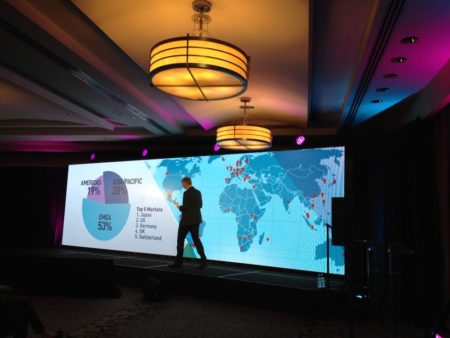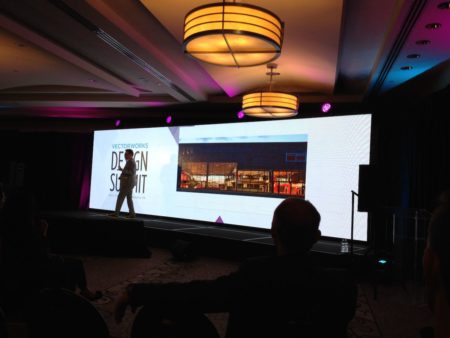Continued from page 1
Notes on Keynotes
Vectorworks Nemetschek CEO Sean Flaherty gave the opening keynote address. The one-hour talk went back through time and covered highlights of the company’s 30 year history, including many illuminating tidbits, one of which was mentioned in our first post on the summit.
1999 was the year that the company changed the name to Vectorworks, from MiniCAD. Flaherty noted that during Apple’s darkest days he really felt that the company was going to not make it. Smartly, MiniCAD was made for Windows during the late 90’s and it led to an explosion in sales. He noted that it was the only true cross-platform general CAD product in existence, and that set Vectorworks apart.

03 – Nemetschek Vectorworks CEO Sean Flaherty during his opening keynote. This image shows the global distribution of Vectorworks.
In 2000 Nemetschek AG acquired Diehl Graphsoft (Vectorworks). At that time annual sales were $8 million USD. From that time until now the company has grown eight fold (8x), with profit growing ten-fold (10x). With over a half million active users around the globe, Flaherty said their next tasks is to grow the company 4x or reach 2 million users. He didn’t elaborate in detail in how the company intends to do that but painted a strategy in broad strokes, including supporting the next generation of designers.
This open admission of size targets was interesting, but it was coming from a company that clearly sees itself accelerating based on its most recent trending. Flaherty noted that part of the problem in the CAD world is that the press and users alike put software solutions into segment categories or “silos.” In other words, are you a BIM program or a CAD program? Are you AEC or CAID? Noting that Vectorworks doesn’t fit neatly into these segment silos, Flaherty discussed how the company’s messaging needs to refine and evolve in order to persuade users to understand that the company cares about and understands “Design.”

04 – Customer Appreciation Party at Vectorworks Design Summit, held in the Philadelphia Museum of Art.

06 – The Philly Art Museum steps were made famous in the Oscar-winning movie “Rocky.” They are a popular workout spot for locals.
Innovative design has to cross silos and be fluid, he noted that “architects know that segments don’t really exist.” Many of its most noted users don’t fit neatly into segment profiles but have a diversity of capabilities. Flaherty stated that Vectorworks is the only tool in the market that can combine best-of-breed BIM, site design and design CAD all in one package.
Finally, in discussing the company’s outlook, Flaherty said that Nemetschek Vectorworks is opening up an Atlanta, Georgia, software development office. This office will be situated directly across the street from Georgia Tech, which it has partnered with. Georgia Tech has one of the world’s leading BIM research programs. It is also one of the US’s leading colleges for computer science majors. The company also has a dedicated research and development team and has hired several PhD’s to support these endeavors. Architosh will get deeper into that in an upcoming feature.
Design Keynote
The design keynote was delivered by architect Leo Van Broeck, of BOGDAN & VAN BROECK. A Belgium based firm, he gave an enlightening talk centered on the theme of densification and sustainability.

07 – Leo Van Broeck’s talk was the opening Design Keynote. On this slide the MAD (media arts design school is shown. It reused an old coal mine factory site. This was just one of several really noteworthy projects shown in Leo’s talk.
Van Broeck’s firm has a talent for the adaptive reuse of abandoned buildings, lots, and complex brownfield sites. While it took nearly two thirds of his talk before the audience could see the firm’s creative output, most, including myself, were already deeply impressed with the research-led discussion. Van Broeck spoke about architects being “doctors of space,” when it comes to reversing the negative impact of buildings on our natural world.
During his talk he dropped several stunning statistics, including that the average pet dog in Europe has a bigger carbon footprint than the average human being in Africa. It was also noted that a super energy efficient single family home, for example, out in a rural setting or deep in suburbia—a car dependent location—has a carbon footprint two and a half times (2.5x) that of an old-style apartment in the city. Van Broeck argued very convincingly that when it comes to achieving lowering the carbon footprint of Man, mobility itself is the problem.
Architects can, of course, make a big difference—one building project at a time. But for Van Broeck, “compacting” should be part of the solution, if not the central part, to sustainability in the wider context.




Reader Comments
RT @architosh: Vectorworks Design Summit: Wrap Up and Details: We have already provided some initial thoughts on the Vect… http://t.co/jp…
RT @architosh: Vectorworks Design Summit: Wrap Up and Details: We have already provided some initial thoughts on the Vect… http://t.co/jp…
RT @architosh: Vectorworks Design Summit: Wrap Up and Details: We have already provided some initial thoughts on the Vect… http://t.co/jp…
RT @architosh: Vectorworks Design Summit: Wrap Up and Details: We have already provided some initial thoughts on the Vect… http://t.co/jp…
RT @architosh: Vectorworks Design Summit: Wrap Up and Details: We have already provided some initial thoughts on the Vect… http://t.co/jp…
RT @architosh: Vectorworks Design Summit: Wrap Up and Details: We have already provided some initial thoughts on the Vect… http://t.co/jp…
Emanuel Machado liked this on Facebook.
Excellent report. Looking forward to the future installments. Thanks for sharing and keeping me in the loop
Excellent report. Looking forward to the future installments. Thanks for sharing and keeping me in the loop
Emanuel Machado liked this on Facebook.
Comments are closed.